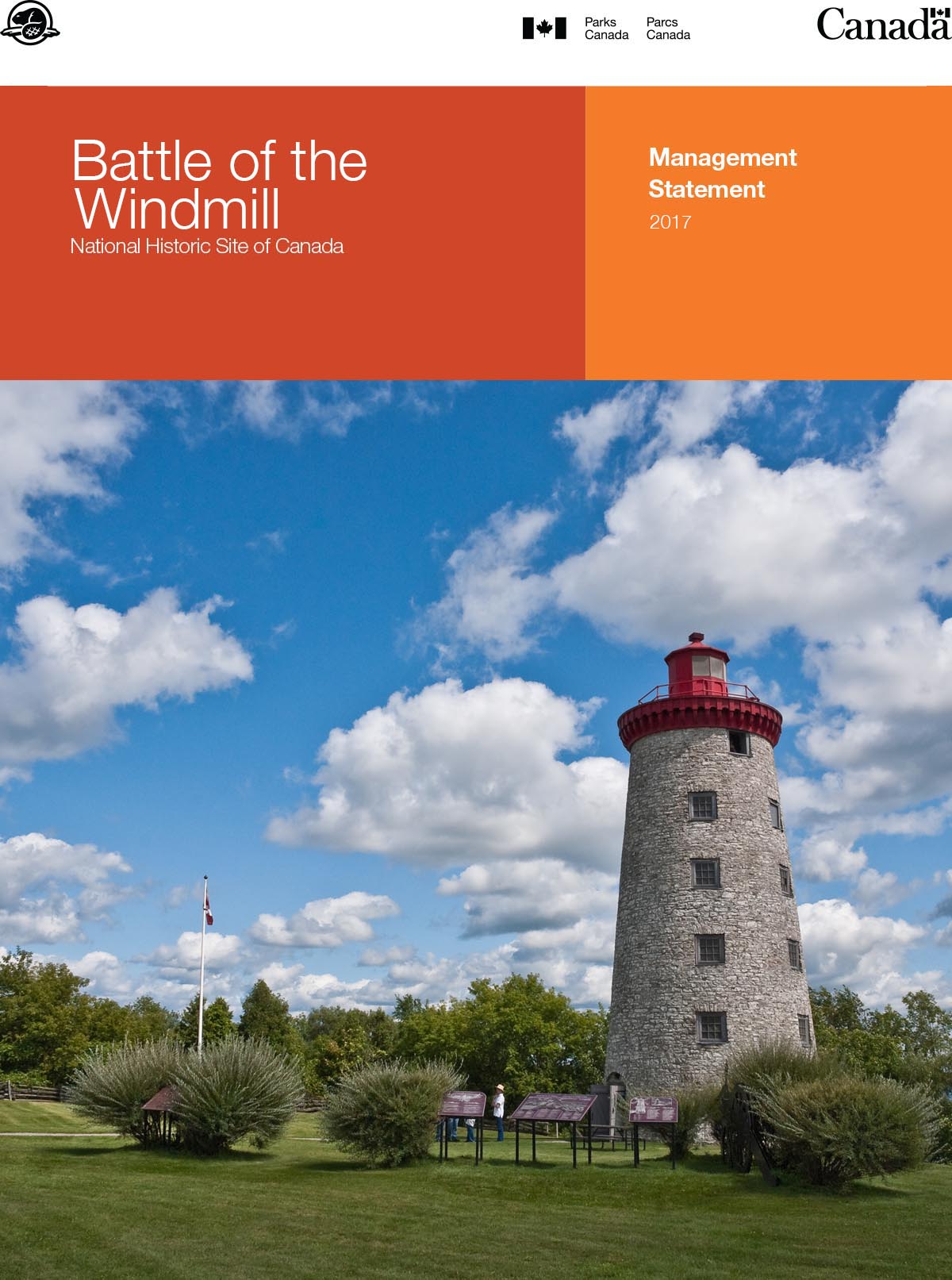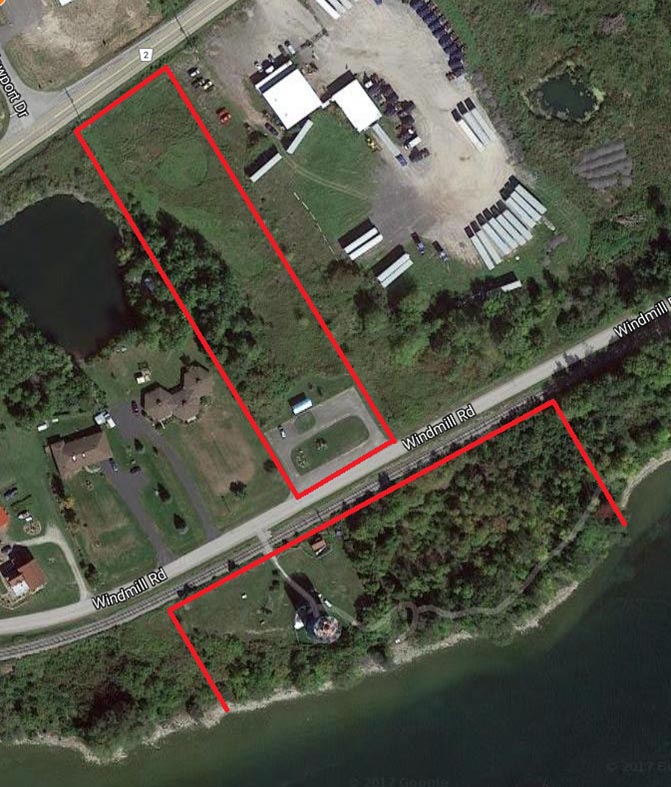Battle of the Windmill National Historic Site of Canada Management Statement 2017
Battle of the Windmill National Historic Site
Table of contents
Maps

© Her Majesty the Queen in Right of Canada, represented by the Chief Executive Officer of Parks Canada, 2017
Cette publication est aussi disponible en français :
Énoncé de gestion du lieu historique national de la Bataille-du-Moulin- à-Vent, 2017
For more information about the management statement or about Battle of the Windmill National Historic Site of Canada:
370 Vankoughnet St. P.O. Box 479
Prescott, ON K0E 1T0
Canada
Approval
Approved by:
Katherine Patterson
Field Unit Superintendent
Georgian Bay and Ontario East Field Unit
Parks Canada
Introduction
The Parks Canada Agency manages one of the finest and most extensive systems of protected natural and historic areas in the world. The Agency’s mandate is to protect and present these places for the benefit and enjoyment of current and future generations. This management statement outlines Parks Canada’s management approach and objectives for the Battle of the Windmill National Historic Site.
The Battle of the Windmill National Historic Site is located east of the Town of Prescott Ontario on the St. Lawrence River in the Township of Edwardsburg / Cardinal.
The site was acquired by the Department of the Interior in 1923 and subsequently designated as a national historic site in 1925. The designation relates to the site’s involvement in the rebellion of 1838 and victory at the site by a British force consisting of imperial and colonial forces over an invading force of American “Hunters” and Canadian rebels.
The historic site consists of an area of land and water surrounding the windmill and extending north of the windmill in a narrow strip of land between old Highway 2 and Highway 2.
The resources of national historic significance consist of the following: the windmill tower, archaeological remains including the structures from the village of Newport destroyed during the battle, artifacts related to the battle, resources from the windmill’s construction, post-battle period, lighthouse conversion and occupation from 1873-1923.
Although not constructed specifically for military use, the imposing physical form and fabric give the windmill landmark status and speak to its defensive use. The heavy masonry construction withstood an artillery bombardment and served as a stronghold during the battle. Over its life, the structure was used as a windmill, barracks, lookout station and ultimately a lighthouse.
In 2014 the Government of Canada announced the designation of Windmill Point lighthouse as a heritage lighthouse under Canada’s Heritage Lighthouse Protection Act.
The structure is an early and excellent example of the adaptive re-use of a building. Initially built as a windmill in 1832, it was converted to a lighthouse and became operational by 1874, remaining in service for over a century. The lighthouse is associated with the system of navigation aids along the St. Lawrence River and Great Lakes and was particularly valuable as a support to the transshipment of goods at the Port of Prescott.
The lighthouse is the centerpiece of the Battle of the Windmill National Historic Site of Canada, which commemorates a notable struggle during the Rebellion of 1837-1838.
Management objectives
Building relationships with Aboriginal Peoples
Parks Canada respects Indigenous rights and land claim agreements. Building mutually beneficial relationships with Indigenous communities is a priority for the Agency. In managing the Battle of the Windmill, Parks Canada will continue to communicate and demonstrate a desire to work with local Indigenous communities to forge mutual arrangements that benefit both parties, including broadening perspectives of Indigenous history, traditional knowledge, values and cultural heritage.
Building relationships with local/regional partners
Stakeholder and partner engagement is a key to integrating the site into the broader community and tourism region. Over the past few years, the site has made progress in building constructive relationships with local communities.
These relationships are in various development stages, and all provide opportunities for growth. Strong relationships create stewards and supporters for Parks Canada. These communities also help diversify the interpretive programs, thus increasing the overall appeal of the Battle of the Windmill NHS as an attraction to visit in Eastern Ontario.
The Friends, with Parks Canada assistance, provide visitor services at the site. The Friends maintain exhibits and hire staff who offer quality visitor experience to visitors from around the world.
Consultation and collaboration with the Town of Prescott and the Township of Edwardsburg/Cardinal is ongoing. This includes tourism initiatives as well as financial support from the municipalities to the Friends of Windmill Point.
With the cooperating association, the Friends of Windmill Point, will encourage and value the increasing participation of volunteers in various aspects of the site’s operation. To this end, the Battle of the Windmill NHS will further community participation in visitor experience offers, including special events. This strategy also ensures that volunteers at the site are fulfilled. The sense of stewardship is strengthened among volunteers to The Battle of the Windmill NHS, and The Friends play a strong and active role in delivering visitor experience offers.
The Battle of the Windmill NHS will become a community place, to which the local population feel passionately connected and take pride in.
Resource conservation
Parks Canada protects cultural resources at its heritage places in accordance with its Cultural Resource Management Policy and the Standards and Guidelines for the Conservation of Historic Places in Canada. This includes basic monitoring of the state of cultural resources, and documentation of interventions at the site. At the Battle of the Windmill, the focus has been the masonry repair project that took place in the summer of 2015 to the spring 2016. This project was funded by Federal Infrastructure Investment program (FII). The scope of work focused on solving the significant issues of water infiltration and humidity of the structure's interior, noted in inspection reports.
The work included re-pointing of masonry, masonry crack repairs, sealing and replacement of windows, metal roof and lighthouse cap repairs, replacement of deteriorated wooden joists, repairs and re-painting of exterior woodwork and metal work of the surmounting lantern. In addition, the interior stair railings were modified for visitor safety reasons. The repairs have greatly improved the condition of the resource and will help to preserve the asset for years to come.
The Battle of the Windmill NHS will offer visitors diverse opportunities to explore and rediscover the charm of the site. The cultural resources (including the buildings, historical objects, and viewscapes as well as landscapes) are the foundation for visitor experiences of the site. By focusing efforts in defining and maintaining those resources that speak directly to the site’s heritage values and character, lending strength to visitor opportunities.
Visitor safety
Parks Canada puts in place appropriate measures to protect the health and safety of visitors to the site. At the Battle of the Windmill, this includes various code compliance inspections on a monthly and yearly basis.
Site maintenance
Parks Canada maintains the property it administers to respect the site’s heritage values, presents a positive image to the public, and reflects the Parks Canada brand. Maintenance of the site is performed by the asset team based out of nearby Fort Wellington National Historic Site. The asset team’s efforts improves visitors’ experiences by providing exceptional presentation and careful maintenance of the site.
Directional signage
Parks Canada keeps signage up-to-date and works with its partners to meet signage standards and requirements. These include the Federal Identity Program, Ontario Tourism Oriented Directional Signing Program and municipal signs. In 2016 the Historic Sites and Monuments Board plaque with Canada’s Heritage Lighthouse designation has been erected on site.
Public understanding and appreciation
Each national historic site is relevant to all Canadians, and communicates its own story, contributing to our understanding of Canada as a whole. The Battle of the Windmill NHS is one of those special places, a living legacy of our heritage. Parks Canada and the Friends of Windmill Point are responsible for facilitating experiences and enabling Canadians to discover and build personal connections to the site.
The site’s operational season is from Canada Day to Labour Day. Over the past five years visitation has remained steady at approximately 5,000 visitors per year.
In 2016 new exhibits and bilingual media presentations were developed to place greater emphasis on presenting messages of national significance. This re-development provides opportunities to increase attendance, enhance the quality of the visitor experience and offers a greater understanding and appreciation of the site.
Parks Canada provides information about the significance of the Battle of the Windmill site on its website, and on the Canadian Register of Historic Places.
A greater awareness of the heritage values of the Battle of the Windmill will provide the basis for a beneficial relationship with the municipality and adjacent landowners to protect the setting of the site.
In the upcoming years Parks Canada will be exploring the visitation and tourism potential for its entire family of National Historic Sites and National Parks along the Lake Ontario – St Lawrence corridor parallel to the 401.
The Battle of the Windmill NHS is a “must-see” place that inspires Canadians as a real place telling real stories about real people.
Map 1: Battle of the Windmill National Historic Site local setting

Battle of the Windmill National Historic Site local setting - Text version
This map shows the administrative boundaries of the Battle of the Windmill National Historic Site, located east of the Town of Prescott Ontario on the St. Lawrence River in the Township of Edwardsburg / Cardinal on Windmill Road.
Related links
- Date modified :